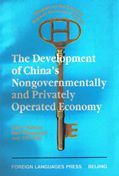The Development of China's Nongovernmentally and Privately Operated Economy (Studies on the Chinese Market Economy)
Publisher:
Foreign Languages Press
Publication:
1/1996
Languages:
English
Binding:
Paperback
ISBN/SKU:
9787119017754
Pages:
216
Sizes:
0 x 0mm
Weight:
0.2370
In Stock (Only 4 copies left)
To be dispatched within 1 business day
To be dispatched within 1 business day
Special Price
£4.74
£4.74
Regular Price
£8.95
(€5.31)
Chinese architecture, art and culture have been greatly influenced by a variety of religions throughout China's history. UNESCO had approved seven Chinese religious sites for inclusion in its World Heritage List by November 2003. Those listed include key Buddist sites such as the Mogao Caves in Dunhuang, the Leshan Giant Buddha near Mount Emei, the Dazu Rock Carvings and the Yungang Grottoes, which have blended carving, mural painting, colored sculpture and architecture into one to become outstanding representatives of ancient Chinese art. The ancient Taoist architectural complex on Mount Wudang is an important site of the indigenous Chinese religion Taoism, and is a treasure house of traditional Chinese architecture. In Tibet, politics and religion are combined in the majestic and splendid Potala Palace -- a group of buildings devoted to Lamaism, a form of Buddhism practiced in Tibet. The palace represents the pinnacle of Tibetan art in terms of architecture, sculpture and painting. It is the crystallization of the wisdom of the Tibetan, Han, Mongolian and Manchurian peoples, among others.




